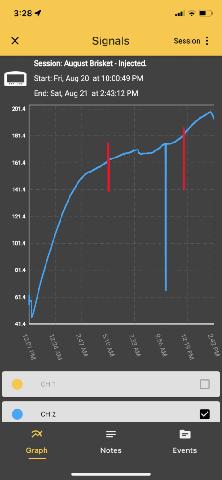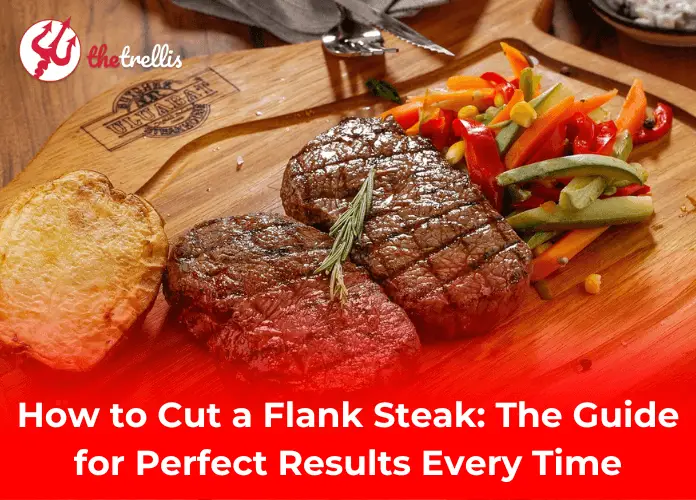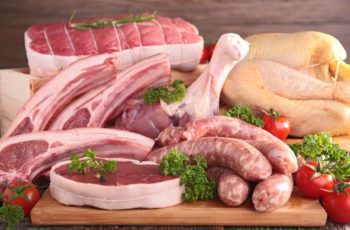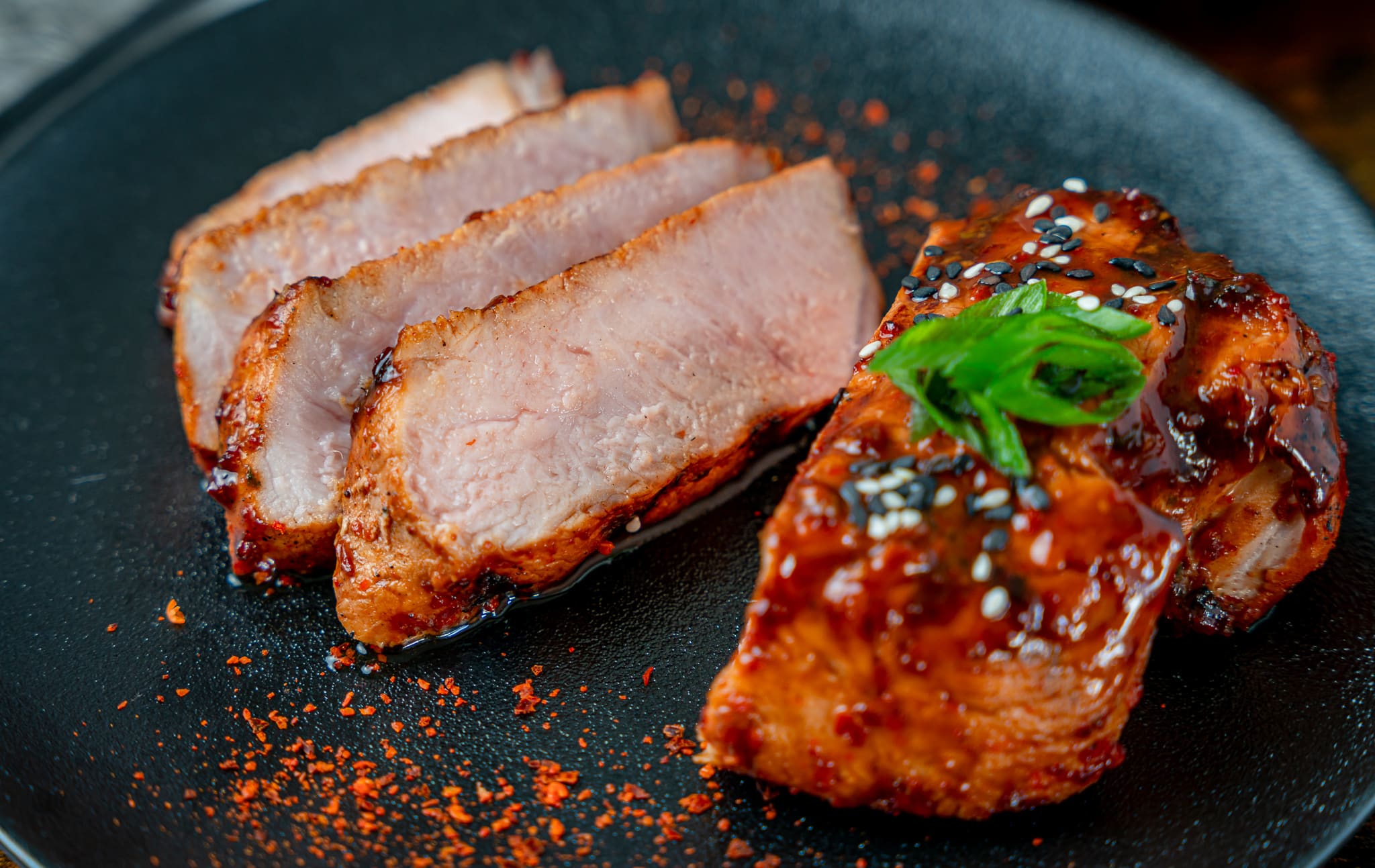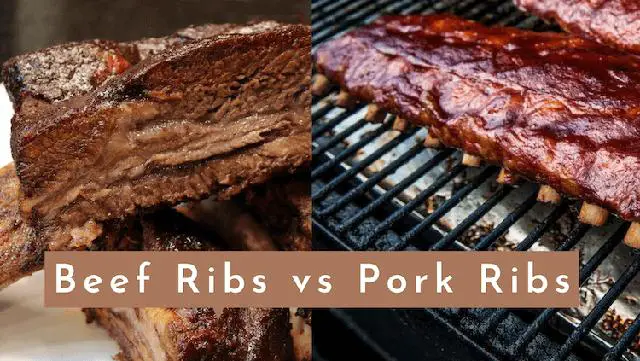
“Beef Ribs vs Pork Ribs: A Battle of Flavors and Tenderness. Explore the mouthwatering world of these two delectable rib cuts as we compare their distinct characteristics, cooking methods, and ultimate dining experience. Get ready to sink your teeth into a sizzling debate that will leave you craving for more!”
What Are Pork Ribs?

Pork ribs are a type of rib cut that comes from pigs. They are a staple in the world of barbecue and are popular in BBQ joints and competitions. There are three standard cuts of pork ribs: baby back ribs, spare ribs, and country-style ribs.
Baby back ribs are a favorite among many people. They come from the rib section closest to the pig’s spine, near the loin. These ribs have a distinctive curvature and most of the meat sits on top of the bone. They are fairly lean and smaller in size compared to spare ribs.
Spare ribs have a decent amount of extra meat and bones along the top of the rack and on the sides. They come from the section of the rib cage closest to the belly of the pig and have a higher fat content than baby back ribs. St. Louis-style spare ribs are trimmed to make them more uniform in shape.
Country-style ribs, although called “ribs,” are actually cut from the shoulder of the hog. They can be bone-in or boneless and have plenty of fat. These meaty ribs require low-and-slow cooking to render out fat and break down connective tissue for tender, flavorful pork.
1. Baby Back Ribs
Baby back ribs are a favorite among many when it comes to pork ribs. They come from the rib section closest to the hog’s spine, near the pig’s loin. These ribs have a distinctive curvature and most of the meat sits on top of the bone, not in between the ribs. Baby back ribs are fairly lean and smaller in size compared to spare ribs.
Spare ribs are another type of pork rib that come from the rib section of a hog. There are two variations of spare ribs: regular spare ribs and St. Louis-style spare ribs. Regular spare ribs have extra meat and bones along the top and sides of the rack. St. Louis-style spare ribs, on the other hand, have been trimmed to make them more uniform in shape.
Country-style ribs are not actually ribs, but rather cuts from the shoulder of a hog. They have plenty of fat and are incredibly meaty. These can be bone-in or boneless, with bone-in country-style ribs being part of the shoulder blade. They are best cooked low and slow to allow the fat to render and connective tissue to break down for tender, delicious pork.
Beef short plate ribs, also known as dino or dinosaur ribs, come from the plate primal on a cow’s ribcage. These large beef ribs have significant amounts of meat on each bone and can resemble brisket in terms of marbling and flavor. A rack of untrimmed short plate beef ribs can weigh around five pounds.
Beef short chuck ribs come from the chuck primal, where chuck roasts can also be found. They have a thick layer of meat on top of each rib, but are not as long as short plate ribs. These ribs are still flavorful and marbled, but less meaty compared to short plate ribs.
Beef back ribs come from the rib primal, where ribeye steaks and prime rib are cut from. They are leaner than other beef rib cuts and most of the meat sits in between the bones. These ribs have a beefy flavor and are a good option for those looking for a leaner alternative to pork ribs.
English cut ribs refer to a method of cutting short ribs, which can be done with either short plate or short chuck ribs. Instead of serving them as a rack, these ribs are cut into individual bones and trimmed down. They can be smoked or braised.
Flanken cut ribs are another trimming style for short plate or short chuck ribs. These ribs are cut across the bones, resulting in thin pieces of meat with slices of bone still in place. They are commonly used in Korean BBQ and can be cooked hot and fast after marinating.
2. Spare Ribs
Spare ribs are another popular type of pork ribs that are commonly used in barbecue. They come from the rib section of a hog and have a decent amount of extra meat and bones along the top of the rack and on the sides. Butchers will often trim them up and sell the trimmings as riblets or rib tips. These ribs have a higher fat content compared to baby back ribs, as they come from the section of the rib cage closest to the belly of the pig and the breastbone.
When it comes to cooking spare ribs, they can be prepared in various ways. Some people prefer to cook them with only a dry rub, while others like to slather them in sauce. Spare ribs are typically larger than baby back ribs and can be quite meaty. They require low-and-slow cooking to allow the fat to render and break down the connective tissue for tender and delicious results.
3. Country-StyleSpare Ribs
Country-style spare ribs are not actually ribs, but rather cuts of meat from the shoulder of the hog. They are similar to the meat found on a pork butt, which is used to make pulled pork. These ribs can be bone-in or boneless, with the bone-in option being part of the shoulder blade. Country-style spare ribs are incredibly meaty and have a high fat content. To achieve tender and delicious pork, these ribs should be cooked low and slow to allow the fat to render and connective tissue to break down. They are a flavorful option for those who enjoy rich and fatty cuts of meat.
What AreBeef Ribs?
Beef ribs are cuts of meat that come from the rib section of a cow. There are three major types of beef rib cuts: short plate ribs, short chuck ribs, and back ribs. These ribs are located low on the ribcage, close to the brisket primal on the cow. Short plate ribs are known for their large size and abundance of meat, earning them the nickname “dino” or “dinosaur” ribs. They can be up to 12 inches long with two-plus inches of meat on top of each bone. Short chuck ribs are shorter in length but still offer a good amount of marbled meat. Back ribs, which come from the rib primal where ribeyes and prime rib are found, have most of the meat situated between the bones.
There are also two different preparations for beef ribs: English cut and flanken cut. English cut refers to individual bones that have been trimmed down from either short plate or short chuck ribs. Flanken cut involves cutting short plate or short chuck ribs across the bones, resulting in thin pieces of meat with slices of bone still intact. Both English cut and flanken cut beef ribs can be found in local grocery stores.
1. Short Plate Ribs
Short plate ribs are one of the types of beef ribs, specifically coming from the plate primal and located low on the ribcage and just behind the brisket primal on the cow. These ribs are known for their large size and abundance of meat, earning them the nickname “dino” or “dinosaur” ribs.
Typically, each rib is around 12 inches long with two-plus inches of meat on top of it. They have a high marbling content, similar to the point of a brisket, which adds flavor when smoked. Even when trimmed, short plate ribs still have six-inch long bones with one to two inches of meat on them. A full rack usually consists of three or four bones and weighs around five pounds.
Short chuck ribs are another type of beef rib that comes from the chuck primal, where chuck roasts are also found. While not as long as short plate ribs, they still have a thick layer (between one and two inches) of meat on top of each rib.
These ribs offer good quality meat with plenty of marbling for added flavor. However, they are less commonly found in supermarkets as a rack of ribs compared to other cuts. To find short chuck ribs, you may need to visit a local butcher shop.
The majority of the meat on beef back ribs sits in between the bones due to their location in the rib primal area where ribeyes and prime rib are also found. As a result, these ribs have less meat on the surface compared to other beef rib cuts.
Beef back ribs are considered leaner than pork ribs but still offer a flavorful option for those who prefer a leaner choice. They are commonly used in prime rib roasts, so the meat is often cut away, resulting in smaller meat portions on the bones.
2. Short Chuck Ribs
Short chuck ribs are a type of beef rib cut that comes from the chuck primal, which is located low on the ribcage and just behind the brisket primal on the cow. These ribs have a thick layer of meat, between one and two inches, on top of each rib. While they are not as long as short plate ribs, they still offer good quality meat with plenty of marbling.
Short chuck ribs are often referred to as “chuck short ribs” and can be cooked in a similar way to brisket. They are usually not available in regular supermarkets and may require you to visit a local butcher shop to find them. The meat on these ribs has a rich flavor due to the marbling, making them a delicious option for beef rib enthusiasts.
3. Back Ribs
Beef back ribs come from the rib primal where you also find ribeyes and prime rib. These ribs are located high on the cow’s ribcage. Unlike pork ribs, most of the meat on beef back ribs sits in between the bones rather than on the surface. As a result, back ribs are the leanest cut of beef ribs. However, they still offer plenty of beefy flavor.
If you or someone you know is looking for a leaner option but still wants to enjoy ribs, back ribs are a good choice. The trimming process for prime rib roasts results in less meat on the surface of these bones, making them leaner compared to other beef rib cuts. Back ribs can be cooked using various methods such as grilling or smoking, and they pair well with different seasonings and sauces.
English CutBeef Ribs
English cut beef ribs are a method of cutting short ribs, whether they are short plate or short chuck ribs. Instead of serving as a rack, these ribs are cut into individual bones and then trimmed down. You can often find English cut beef ribs in local grocery stores. They can be smoked, but it is also common to braise these ribs by first searing them and then cooking them low and slow in a liquid.
Flanken CutBeef Ribs
Flanken cut beef ribs are a type of beef rib that is cut across the bones, resulting in thin pieces of meat with slices of bone still in place. This style of cutting is popular in Korean BBQ and lends itself well to hot and fast cooking methods. Flanken cut beef ribs can be found in local supermarkets and are often marinated before being cooked.
Pork RibsVSBeef Ribs: What Are The Differences?
When it comes to barbecue ribs, there are significant differences between pork ribs and beef ribs. Firstly, in terms of size and amount of meat, beef ribs are generally larger and contain more meat than pork ribs. A single short plate beef rib can be equivalent to half a rack of pork ribs. The exception is beef back ribs, which have less meat due to the prime rib being cut away.
Another difference lies in the marbling of the meat. Beef short ribs have much more marbling than pork ribs, resulting in a richer and stronger flavor. The intramuscular fat in beef ribs renders out during smoking, adding even more flavor compared to pork ribs. However, if you prefer a milder taste or want to showcase your BBQ dry rub or sauce, pork ribs may be the better choice.
In terms of cost and availability, pork ribs tend to be cheaper and more readily available in grocery stores compared to beef ribs. Pork ribs are common staples in most supermarkets, while finding a rack of beef short plate or chuck ribs may require a visit to a local butcher shop.
Size/Amount Of Meat
When comparing beef ribs to pork ribs, one noticeable difference is the size and amount of meat on the ribs. Beef ribs tend to be larger and contain more meat compared to pork ribs. This is because cows are generally larger animals than hogs. A single short plate beef rib can be as long as 12 inches with two-plus inches of meat on top of it, earning it the nickname “dino rib” or “brisket on a stick.” In contrast, pork ribs, such as baby back ribs or spare ribs, are smaller in size and have less meat on them. You might eat half a rack of pork ribs compared to just one short plate beef rib.
The amount of marbling, which refers to intramuscular fat in the meat, differs between beef and pork ribs. Marbling plays a significant role in flavor as it renders out during the smoking process. In general, beef short ribs (both chuck and plate) have much more marbling than pork ribs. Spare ribs have more marbling than baby back ribs but still cannot compete with beef short ribs in terms of marbling and flavor. Therefore, if you prefer a stronger flavor profile and enjoy the richness that comes from marbled meat, beef ribs would be a better choice.
The flavor profiles of beef and pork differ naturally due to their inherent qualities. Beef has a stronger flavor compared to pork, which tends to have a milder taste. As a result, beef ribs generally offer a bolder and richer flavor experience compared to pork ribs. If you prefer the taste of the meat itself without heavy seasoning or sauces, then beef ribs would be more suited to your palate. On the other hand, if you enjoy using dry rubs or barbecue sauces to enhance the flavor, pork ribs may be more to your liking.
Marbling
Marbling refers to the intramuscular fat found in meat. It is responsible for adding flavor and moisture to the meat during cooking. When it comes to marbling, beef ribs tend to have more than pork ribs. Both short plate and short chuck ribs from beef have a higher amount of marbling compared to pork ribs. Even spare ribs from beef have more marbling than baby back ribs from pork. The presence of marbling in beef ribs contributes to their stronger flavor and juiciness.
The flavor of beef ribs and pork ribs differs due to the inherent taste of the meat itself. Beef has a stronger and richer flavor compared to pork. This makes beef ribs ideal for those who prefer a bold and robust taste without relying heavily on seasonings or sauces. On the other hand, if you enjoy using dry rubs or barbecue sauces that enhance the flavor of the meat, pork ribs may be more suitable for you. Pork has a milder flavor that can easily complement various seasonings and sauces.
In general, pork ribs tend to be cheaper than beef ribs. The price difference can vary, but you can expect to pay at least $1.50 more per pound for beef ribs compared to pork ribs. Short plate ribs are typically the most expensive among all types of beef ribs. Due to their availability and lower cost, pork ribs are commonly found in grocery stores, while finding a rack of beef short or chuck ribs might require visiting a local butcher shop.
Pork ribs generally cook faster than beef ribs. Baby back ribs cook faster than spare ribs from both pork and beef categories. Beef back rib cooking time is comparable to that of baby back rib cooking time. It’s important to note that the 3-2-1 method, which involves three hours of smoking, two hours of wrapping in foil, and one hour of basting with sauce, is not recommended for pork ribs. Each type of rib requires specific cooking techniques and times to achieve optimal tenderness and flavor.
Flavor
Beef ribs have a stronger flavor compared to pork ribs. Pork doesn’t have a strong flavor on its own, while beef has a more pronounced taste. The marbling in beef ribs adds to the flavor as the intramuscular fat renders out during smoking. Beef short ribs, both chuck and plate, have more marbling than pork ribs, making them even more flavorful. If you prefer ribs that let the natural taste of the meat shine through, beef ribs are a good choice. However, if you enjoy using dry rubs or barbecue sauces to enhance the flavor, pork ribs may be more suitable.
Cost
Pork ribs, whether spare or baby back ribs, tend to be much cheaper than beef ribs. The differences can vary widely, but you’ll pay at least $1.50 more per pound for beef ribs over pork ribs with short plate ribs being the most expensive of them all.
Due to their longstanding, iconic nature, pork ribs are quite common in grocery stores. You don’t need to go to a local butcher to find a rack of spare ribs. You might not always be able to find St Louis cut spare ribs, but chances are you can find a rack of spare ribs or baby back ribs with regularity. You can find English cut short ribs and flanken ribs at a grocery store fairly frequently as well. However, finding a rack of beef short plate or chuck ribs is extremely unlikely if you’re just at your friendly neighborhood supermarket. Like me, you’ll need to find a good local butcher shop.
Not only are pork ribs more readily available, they also tend to cook faster. Baby back ribs cook faster than spare ribs, and beef back ribs are fairly comparable in cooking time. Just don’t use the 3-2-1 method to smoke your pork ribs. Instead, check out Michael Symon’s recipe for smoked baby back ribsthat takes less time but still produces delicious results.
Availability
Pork ribs, whether baby back ribs or spare ribs, are widely available in grocery stores and supermarkets. They are a common staple in the world of BBQ and can be easily found for purchase. You can typically find baby back ribs and spare ribs with regularity, although St. Louis-style spare ribs may not always be available.
Beef ribs, on the other hand, are less commonly found in regular grocery stores. While you may occasionally come across English cut short ribs or flanken cut ribs, it is unlikely to find a rack of beef short plate or beef short chuck ribs at a typical supermarket. To purchase beef ribs, it is best to visit a local butcher shop where they may have these cuts available.
Cook Times
Cooking times for ribs can vary depending on the type of rib and the desired level of tenderness. Pork ribs generally cook faster than beef ribs due to their smaller size and leaner meat. Baby back ribs, which are smaller and leaner than spare ribs, typically take about 2-3 hours to cook at a temperature of 225°F to 250°F. Spare ribs, with more fat and connective tissue, may take closer to 4-6 hours to become tender when cooked at the same temperature.
Beef back ribs, on the other hand, require longer cooking times due to their larger size and denser meat. These ribs can take anywhere from 4-6 hours or more to reach desired tenderness when smoked at a temperature of 225°F to 250°F.
When it comes to short plate or short chuck beef ribs, the cooking time will depend on whether they are cooked as a rack or cut into individual bones. A full rack of short plate or short chuck beef ribs can take around 5-7 hours to cook until tender when smoked at a temperature of 225°F to 250°F. However, if the ribs are cut into individual bones (English cut or flanken cut), the cooking time will be shorter, typically around 3-4 hours.
Which Is Better, Pork Or Beef Ribs?
When it comes to determining which is better, pork ribs or beef ribs, it ultimately depends on personal preference. Both types of ribs have their own unique qualities and flavors that appeal to different tastes.
Pork ribs, whether they are baby back ribs or spare ribs, are a staple in barbecue joints and competitions. They are known for their tenderness and juicy meat. Baby back ribs, in particular, have a distinctive curvature and leaner meat that sits on top of the bone. Spare ribs, on the other hand, have more fat content and additional meat along the top of the rack. Pork ribs also tend to be more readily available and cook faster than beef ribs.
Beef ribs come in different cuts such as short plate ribs, short chuck ribs, and back ribs. These rib cuts offer a larger size and more meat compared to pork ribs. Short plate ribs are often referred to as “dinosaur” or “brisket on a stick” due to their size and marbling. Short chuck ribs are shorter but still offer a good amount of marbling for flavor. Back ribs from beef tend to be leaner with most of the meat situated between the bones. The marbling in beef ribs gives them a stronger flavor profile compared to pork.
In conclusion, if you prefer tender and juicy meat with less fat content, pork ribs may be your go-to choice. On the other hand, if you enjoy larger portions with rich flavors from marbling, beef ribs would be worth exploring.
What Are The Best Ribs For Smoking, Beef Or Pork?

When it comes to smoking ribs, both beef and pork offer delicious options. It ultimately depends on personal preference and the desired flavor profile.
Pork ribs, such as baby back ribs or spare ribs, are a popular choice for smoking. They are readily available in most grocery stores and tend to cook faster than beef ribs. Pork ribs have a milder flavor compared to beef and can be easily seasoned with dry rubs or paired with barbecue sauce for a sweet and savory experience.
On the other hand, beef ribs, particularly short plate ribs or short chuck ribs, offer a stronger flavor profile due to their higher marbling content. These larger cuts of meat provide a rich and beefy taste that can be enhanced with simple seasonings like salt and pepper. However, beef ribs may be harder to find in regular supermarkets and often require a visit to a local butcher shop.
Final Thoughts
In conclusion, beef ribs and pork ribs have several differences in terms of size, meat content, marbling, flavor, cost, availability, and cooking time. Beef ribs, such as short plate ribs, short chuck ribs, and back ribs, are generally larger and contain more meat compared to pork ribs. They also have higher marbling content, resulting in a stronger beef flavor.
On the other hand, pork ribs like baby back ribs and spare ribs are more commonly found in grocery stores and tend to be cheaper than beef ribs. They cook faster than beef ribs and can be easily prepared with various seasonings or sauces to enhance their taste.
Ultimately, the choice between beef ribs and pork ribs depends on personal preference. If you prefer a leaner option with a prominent beef flavor, beef ribs may be the better choice. However, if you enjoy tender and flavorful meat that can be easily seasoned or sauced up, pork ribs are a great option. Regardless of your choice, both types of ribs offer delicious options for barbecuing or smoking.
FAQS
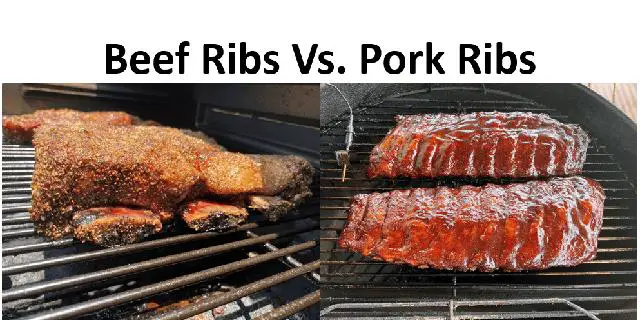
1. Are ribeye steaks and ribeye roasts related to beef ribs?
No, ribeye steaks and ribeye roasts are not directly related to beef ribs. Ribeye steaks are cut from the rib section of the cow, but they do not include the actual ribs. Ribeye roasts are larger cuts of meat that come from the same area as ribeye steaks, but they are boneless. Beef ribs, on the other hand, come from different sections of the cow and have their own distinct cuts.
2. Which is better for smoking – pork or beef ribs?
The choice between smoking pork or beef ribs ultimately comes down to personal preference. Pork ribs, such as baby back ribs and spare ribs, are a favorite in BBQ joints and competitions due to their tenderness and flavor. Beef ribs, like short plate ribs and back ribs, offer a stronger beefy flavor and more marbling for added richness. Both types can be delicious when properly smoked and seasoned.
3. What are the differences between pork and beef ribs?
Pork ribs, including baby back ribs and spare ribs, come from pigs and have a leaner meat with most of it sitting on top of the bones. Beef short plate ribs and chuck short ribs have more marbling and a thicker layer of meat on top of the bones compared to pork ribs. Beef back ribs have less meat on the surface due to their proximity to prime rib cuts. Overall, beef ribs tend to have a stronger flavor than pork ribs.
Question: DoRibeye SteaksAndRibeye RoastsHave Anything To Do WithBeef Ribs?
Ribeye steaks and ribeye roasts are not directly related to beef ribs in terms of being cut from the same part of the cow. While beef ribs come from the rib section of the cow, ribeye steaks and ribeye roasts are cut from a specific muscle within that section called the rib eye muscle. This muscle is known for its tenderness and marbling, making it highly desirable for steaks and roasts.
Ribeye steaks are typically boneless cuts that are sliced from the rib primal, while ribeye roasts are larger cuts that include the bone. These cuts are known for their rich flavor and juicy texture due to the high fat content in the meat. They can be cooked using various methods such as grilling, broiling, or roasting.
Question: Can I Cook Ribs On TheGrill?
Yes, you can absolutely cook ribs on the grill. In fact, grilling is one of the most popular methods for cooking ribs. It allows for that delicious smoky flavor and charred exterior that many people love. To cook ribs on the grill, you will need to follow a few steps. First, you’ll want to season your ribs with your choice of dry rub or marinade. Then, preheat your grill to medium heat and set up a two-zone fire by placing the coals on one side of the grill and leaving the other side free of direct heat. Next, place your ribs directly over the indirect heat side of the grill and cover with the lid. Let them cook slowly for about 2-3 hours, turning occasionally and basting with barbecue sauce if desired. Finally, check for doneness by inserting a meat thermometer into the thickest part of the meat – it should read around 145-165°F for pork ribs or 135-150°F for beef ribs.
In conclusion, beef ribs and pork ribs both offer unique flavors and textures, catering to different taste preferences. While beef ribs are known for their rich and intense flavor, pork ribs are often praised for their tenderness and versatility. Ultimately, the choice between the two comes down to personal preference and desired culinary experience.
Learn More About Grilling
If you want to learn more about grilling, check out these other helpful resources!

